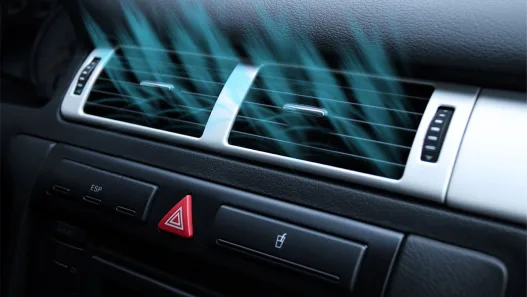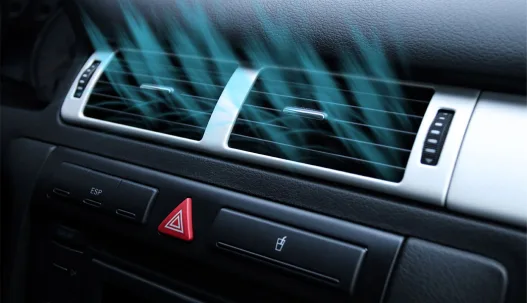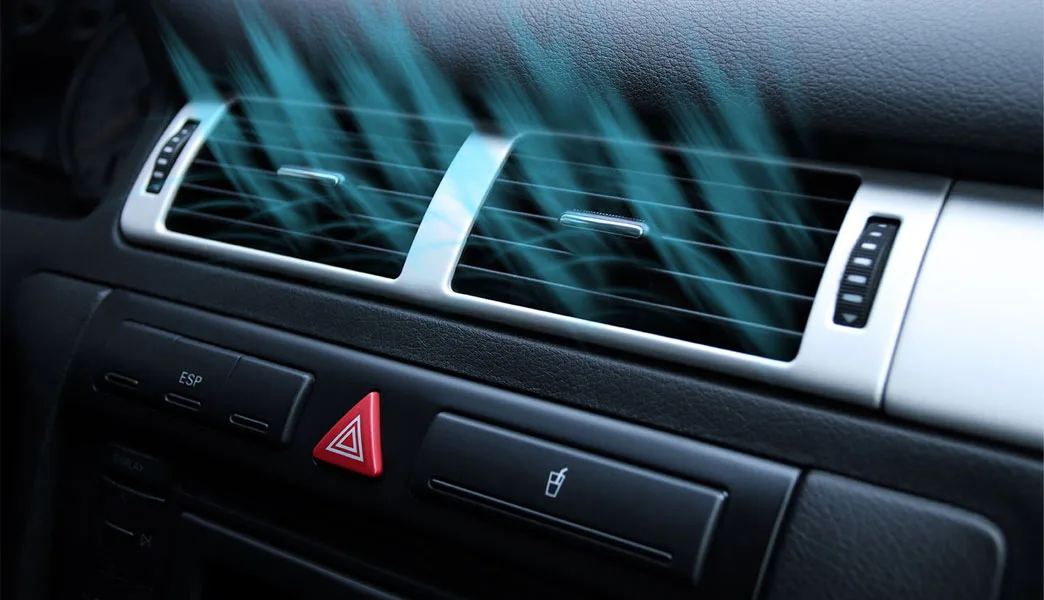Yesterday, I went for lunch with my brother, and the parking lot was a few minutes’ walk from the restaurant. That meant we had to walk in the scorching heat both to and from the restaurant. By the time we returned, the sun was blazing, and all I could think about was reaching my car and relaxing.
The moment I sat inside, the first thing I did was turn on the air conditioning. Within moments, cool air fills the cabin, making the drive home far more comfortable.
For many drivers, the air conditioner is one of the most essential features in a vehicle. It doesn’t just keep you cool; it transforms the entire driving experience, no matter how hot it is outside. But have you ever wondered: How does a car AC work?
It’s not just about filling the car cabin with cold air; it’s also about a fascinating combination of science and engineering that keeps the temperature under control. In simple words, a car’s air conditioning system works by removing heat and humidity from the air inside your vehicle and turning it into a cool, refreshing breeze.
Let’s break down the working of a car’s air conditioning system in a simple, easy-to-understand way in the article below.
Key Components of a Car’s Air Conditioning System
Before learning about the working of a car’s air conditioning system, let’s discuss the key components involved in the process.
1. Refrigerant
A refrigerant is a chemical substance used in cooling and air conditioning systems to absorb heat from a cold indoor environment and release it to a warm outdoor space, while circulating between them.
2. Compressor
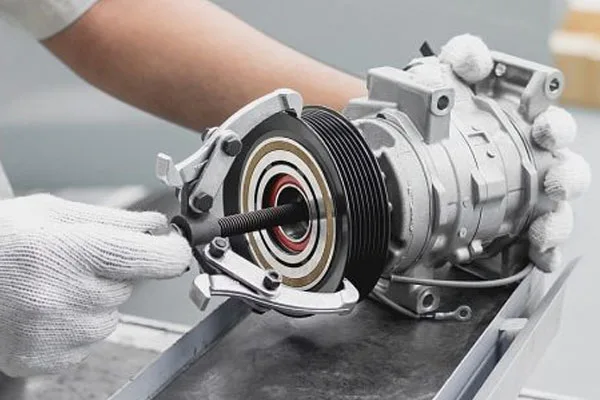
A compressor is the heart of a car’s air conditioning system. It is a pump driven by a belt attached to the engine’s crankshaft. A compressor is responsible for compressing low-pressure refrigerant gas into a high-pressure, high-temperature state.
This is a crucial step because it prepares the refrigerant to release heat once it enters the condenser. Without the compressor, the entire process of cooling the car’s cabin comes to a halt.
3. Condenser
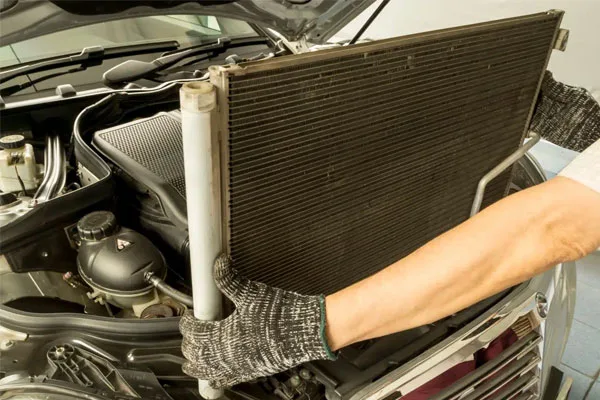
The next component is a condenser, a radiator that works just like the compressor, drawing heat out of the system. The high-pressure refrigerant from the compressor enters the condenser.
Air flowing through the fins and tubes of the condenser cools down the refrigerant, changing the state of the gas to a high-pressure liquid.
4. Receiver/Dryer or Accumulator
The receiver/dryer or Accumulator contains desiccants and small granules that are responsible for removing any moisture from the refrigerant.
If the moisture enters the air conditioning system, it will react with the metal surfaces and mix with the lubrication oil, creating acids and sludge build-up, leading to the complete failure of the system.
5. Expansion Valve
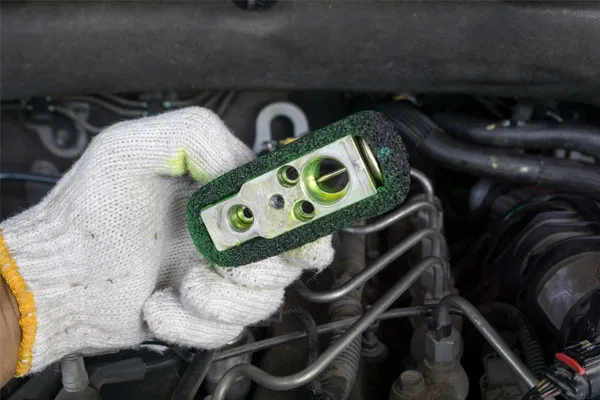
In an expansion valve, the pressure is reduced on the refrigerant to allow it to move into the evaporator. The valve regulates the flow of refrigerant, which allows the system to operate steadily.
6. Evaporator
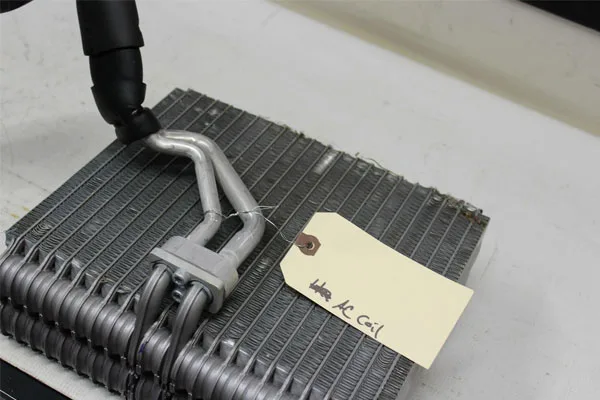
The evaporator is present in the cabin, usually above the footwell on the passenger side. It looks similar to the radiator, containing a coil of tubes and fins. As the low-pressure refrigerant evaporates, it absorbs heat from the cabin air.
When the fan blows air over the evaporator fins, it results in the cool air entering your car’s cabin.
7. Blower Fan
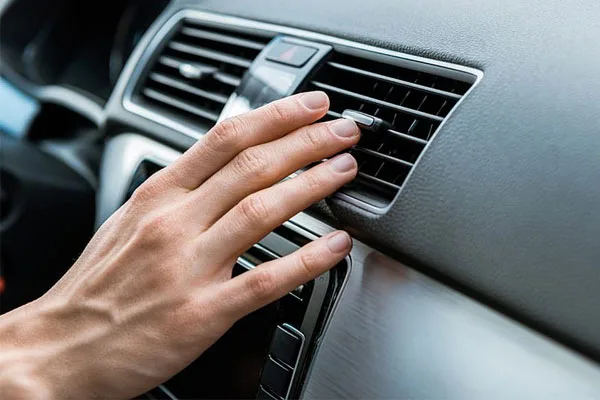
Finally, a blower fan is responsible for pushing cold air from the evaporator through the vents into the cabin. You can control the fan speed, airflow direction, and temperature.
Step-by-Step: How Car AC Works
Now that you know the key components of a car’s air conditioning system, let’s walk through the actual process step by step.
Step 1: Refrigerant Compression
It all begins with the refrigerant compression. The refrigerant enters the compressor as a low-pressure gaseous form, where it is put under extreme pressure (250psi-400psi), compressing into a high-pressure, high-temperature state.
Step 2: Changing the State of the Gas (Refrigerant) to a High-Pressure Liquid
The refrigerant in the form of hot, high-pressure gas travels to the condenser, located in front of the radiator. With outside air flowing through the fins and tubes of the condenser, the refrigerant cools down.
During the process, the refrigerant changes state, from a high-pressure gas into a high-pressure liquid.
Step 3: Expansion and Cooling
Next, the high-pressure liquid refrigerant flows through the expansion valve, where it is allowed to expand. During the expansion, the pressure on the refrigerant is reduced so that it can move into the evaporator.
This process turns the refrigerant into a cold, low-pressure liquid.
Step 4: Heat Absorption
The cold, low-pressure liquid refrigerant now enters the evaporator inside the cabin, above the footwell on the passenger side. The warm air inside the car’s cabin is blown over the evaporator fins, and as the refrigerant absorbs the heat, it evaporates into a low-pressure gas again.
During this process, the cabin is cooled and dehumidified.
Step 5: Blowing Cool Air
Last but not least, the blower fan under the dashboard pushes the cooled, dry air from the evaporator into the car’s interior. Meanwhile, as the refrigerant turns into a low-pressure gas, it returns to the compressor, and the entire process starts again.
Common Car AC Problems

Over time, wear and tear, lack of maintenance, or environmental factors can cause problems with your car’s air conditioning system. Here are some of the most common car AC problems.
- Low or Refrigerant Leaks: One of the most common car AC problems is low or refrigerant leaks caused by ruptured hoses or poor connections. Without enough refrigerant, the AC can’t absorb and release heat properly, also leading to compressor failure.
- Faulty Compressor: As mentioned above, the compressor is the heart of a car’s air conditioning system, so it is under constant pressure. Over time, it may wear out or fail, especially if the AC isn’t used regularly.
- Clogged Condenser: Sometimes, dirt, debris, or even bugs can block airflow through the condenser, reducing its ability to release heat.
- Electrical Issues: A car’s air conditioning system relies on sensors and switches. If there’s a blown fuse or a sensor malfunction, the AC may not work correctly. These minor electrical problems can turn into bigger issues.
Signs Your Car AC Needs Attention
Your car’s air conditioning system doesn’t stop working overnight. Several signs will warn you that your car’s AC is in trouble.
- No Cooling: Your car’s AC will stop blowing cold air due to a refrigerant leak. The air cooling process relies heavily on the refrigerant. If there isn’t enough refrigerant, the air conditioning components will not function properly.
- AC Smells Like Mildew: When you turn on your car’s AC, a noxious smell of mildew hits your nostrils. It mainly happens due to the growth of bacteria in the system. It is familiar with vehicles, in which AC is being used at the maximum setting.
- Strange Noises When AC is On: If you hear a strange noise after turning on your car’s AC, it is a clear sign of trouble in the air conditioning system. Over time, road debris blocks the unit and produces all sorts of unusual noises. It could also be an indication of the failure of a significant component.
- Water on the Floorboards: If you notice water dripping onto the floor of your car, your car’s AC is in trouble. Over time, bacteria build up on the air conditioner’s evaporator coil. The bacteria mix with the condensation, creating a slimy film on the AC fins, clogging the drain line. Once clogged, water from the condensation fills up the heater box and drips onto the floorboard, typically on the passenger side.
- AC Suddenly Starts Blowing Hot Air: When you’re driving and the AC suddenly starts blowing hot air, there is a possibility that the expansion valve has been blocked. It prevents the refrigerant from reaching the evaporator, resulting in hot, uncomfortable air inside the cabin.
Tips For Maintaining Your Car’s Air Conditioning System

You can follow these tips to ensure that your car’s AC keeps running properly.
1. Use Your Car AC Regularly
Make sure to use your car’s AC regularly to keep the compressor lubricated and prevent seals from drying out, reducing the risk of leaks. During the winter season, run the air conditioning system for at least 10-15 minutes once a week.
2. Clean/Replace the AC Filter Regularly
Over time, the AC filter clogs due to dirt, dust, and other particles, reducing airflow. It could also cause cooling to become ineffective, leading to overworking the air conditioning system and resulting in complete failure in the future.
Therefore, make sure to replace or clean the AC filter after a specific mileage.
3. Keep Checking the Refrigerant Levels
You should keep checking the refrigerant levels to ensure your car’s AC keeps running properly. Without enough refrigerant, the cool air production in the cabin becomes ineffective.
It is necessary to keep checking and refilling the refrigerant to enhance your vehicle’s air conditioning system. Make sure to perform this process in the presence of a professional, so that the correct amount and type of refrigerant is used.
4. Keep the Condenser Clean
As discussed above, a condenser is responsible for changing the refrigerant from a high-pressure gaseous form to a liquid form to remove the heat. If there is dirt built up in the condenser, the heat will not be removed from the refrigerant, lowering the AC performance.
Therefore, make sure to keep the condenser clean.
5. Inspect Drive Belts
Your vehicle has a series of belts that are responsible for driving the compressor, enabling refrigerant recirculation in the air conditioning system. If these belts are worn out, loose, or cracked, it may render the compressor, negatively affecting the efficiency level of the car’s AC.
6. Use the Recirculation Mode
Sometimes, activating the recirculation mode on your car’s AC can minimize the time taken to cool the interior of the car vents. By doing this, there will be no excessive supply of cool air, making the AC thermostat able to function better and make the car cooler in a shorter time.
7. Always Park Your Car in the Shade
Parking your car in a shady region will significantly help the AC work properly. A vehicle parked in the sun can make the cabin too hot, and therefore, the AC will have to be used aggressively to cool down the space.
Make sure to always park your car under a tree or inside the garage to lower the temperature inside the vehicle and reduce the load on the air conditioning system.
8. Ensure Proper Insulation
If your car is not adequately insulated, it will allow cool air to escape, resulting in the air conditioning system working hard. Poor insulation also increases fuel consumption. Therefore, ensure that seals around your car’s windows and doors are not worn out.
9. Do Not Overwork the Electrical System
Modern cars are equipped with countless electronics. Using numerous electronic attachments along with the AC may cause operational stress on the car’s electrical system. Therefore, you should not overwork the electronic devices to keep the AC working properly.
10. Don’t Turn on the AC Immediately After Starting the Car
Make sure not to turn on the AC immediately after starting your car. Instead, you have to first roll down the windows and let the hot air escape, then turn on the AC. It will reduce the strain on the system and cool down the cabin faster.
11. Schedule Regular AC Servicing
Just like your car’s engine, the air conditioning system also needs regular servicing from a professional. A qualified technician can carefully inspect the AC components, detect leaks, clean the system, and recharge refrigerant if needed.
How Much Does it Cost to Fix a Car’s Air Conditioner?
Want to know how much it costs to fix a car AC? If so, below is the breakdown of some repair costs to help you understand better.
- AC System Inspection: $122-$179
- AC Recharge: $150-$300
- Refrigerant Leak: $150–$1,000
- AC Hose Repair: $150-$400
- Replacement of AC Hose: $300-$800
- AC Filter Replacement: $76-$113
- Compressor Clutch Replacement: $651-$783
- New Compressor: $800-$1,500
- AC Expansion Valve Replacement: $237-$574
- Condenser Repair: $300–$900
- Electrical Issues: $150–$500
- New car AC installation or total system replacement: $1,500-$4,000
Bonus Section: Eco-Friendly Advancements in the Car AC System
While staying cool is essential to have a comfortable driving experience, the air conditioning system can harm the environment, mainly due to refrigerants that contribute to global warming.
Thankfully, car manufacturers are making significant strides toward greener, more efficient air conditioning systems. Let’s discuss them below:
- Transition to Low-Impact Refrigerants: In older cars, R-134a refrigerant is used, which has a high global warming potential. Instead of it, R-1234yf, a more eco-friendly refrigerant, is being used in modern vehicles.
- Electric Compressors: In hybrid and electric cars, an electric compressor is used that not only improves efficiency but also allows the AC to run even when the engine is off.
- Improved AC System Efficiency: Nowadays, manufacturers are designing smaller, lighter, and more efficient AC systems to reduce energy demand. It will not only help to reduce global warming, but also improve fuel economy.
- Integrating Climate-Control Technology: Modern cars come with innovative climate-control technology that optimizes cooling based on cabin temperature and passenger load. It reduces the unnecessary use of AC, thus cutting down the energy waste and emissions.
Wrapping Up
Your car’s air conditioning system may feel like magic. You pressed the button, and within a minute, the cabin cools down, giving you a comfortable driving experience. It is not that simple; there is a clever mix of science and engineering at work.
From the compressor, which is the heart of the air conditioning system that drives the cycle, to the evaporator that cools the cabin, every component plays a vital role in keeping you cool and comfortable on the road.
Understanding the working of a car’s AC will not only satisfy your curiosity, but it will also help you recognize problems and keep the system working correctly.
As the technology continues to evolve, car air conditioning systems are becoming more intelligent, greener, and more energy-efficient. So whether you’re cruising through city traffic or taking a long road trip, a well-functioning air conditioning system is essential to make your every journey cooler, safer, and more enjoyable.
Sources: Auto Blog, Jack Frost, Sun Devil Auto, Indus Motors, KwikFix Auto
Frequently Asked Questions
1. Are Car AC and Home AC the Same?
While both systems use refrigerant, compression, and evaporation to cool air, a car AC is compact, mobile, and powered by the engine. A home AC runs on electricity, is larger, and is designed to cool bigger spaces continuously.
2. Does Car AC Use Fuel?
In traditional cars, the compressor is powered by the engine, which slightly increases fuel consumption.
3. Why Does My Car AC Blow Hot Air Sometimes?
Sometimes the car AC blows hot air due to low refrigerant levels, a clogged condenser, or a failing compressor. Electrical or sensor issues can also prevent the system from cooling properly.
4. Does a Car AC Affect Engine Performance?
Since the AC compressor is powered by the engine, you may notice reduced acceleration or fuel efficiency when the AC is on, especially in smaller cars.
5. Can I Run My Car AC Without Refrigerant?
Without refrigerant, your AC can’t absorb and release heat, so it won’t cool the air.
6. Why Does Water Drip Under My Car When the AC is On?
Water dripping under your car is simply condensation from the evaporator draining outside.
7. Is It Bad to Run the AC All the Time?
You can run your car’s AC as long as needed. In fact, regular use keeps the system lubricated and prevents seals from drying out.
8. Why Does My Car AC Smell Bad?
A musty odor from your car AC often indicates mold or bacteria inside the evaporator or a dirty cabin air filter.
9. How Do I Know If My Car Needs More Refrigerant?
Some common signs of low refrigerant level are weak cooling, AC blowing warm air, or hissing noises from the system.
10. Can I Recharge My Car AC Myself?
While DIY recharge kits exist, it’s best to let a highly-trained technician handle it. Overcharging or using the wrong refrigerant can damage the system.
11. How Do I Know What Refrigerant My Car Uses?
If you want to refill the refrigerant yourself, it is important to use the correct refrigerant. Every vehicle comes with a label that indicates what refrigerant is used. However, each air conditioning system has refrigerant taps of different sizes to help ensure that only the correct refrigerant is used in your vehicle.
12. Does Using the AC Decrease Fuel Economy?
Running the AC adds load to the engine, which can reduce fuel efficiency by 5–10%.






